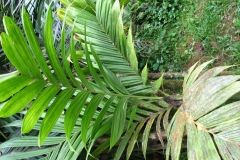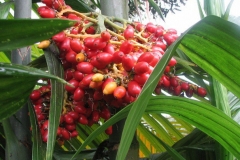The species can attain the height of 30 feet. Trunks are green in new parts and grayish in older parts, thin and elegant and not more than three inches in diameter which is encircled with widely spaced whitish circles of leaf base scars. Crownshaft is smooth, green, barely bulging at base and about 3 to 4 feet high. The leaves resemble betel nut palm. Leaves are dark green with large fused terminal leaflets and generally no more than six leaves per trunk. Palms are monoecious having both male and female flowers in each inflorescence and latter emerges from beneath crownshaft. Blossoms are tiny, fragrant, greenish white producing clusters of 1 inch wide which is followed by ovoid and brownish orange to reddish orange fruits.
Traditional uses
Mix the Wild Areca Palm seeds with pepper Piper betel leaves, gum and lime. This is used to stimulate saliva flow, suppress hunger, accelerate heart and perspiration rates and offer protection against intestinal worms.
Culinary uses
- Nuts are used as a substitute for Areca catechu.
- Palm heart or palm cabbage is consumed raw as salad or cooked.
References:
http://www.plantnames.unimelb.edu.au/Sorting/Areca.html
https://www.itis.gov/servlet/SingleRpt/SingleRpt?search_topic=TSN&search_value=500794#null
https://en.wikipedia.org/wiki/Areca_triandra
http://tropical.theferns.info/viewtropical.php?id=Areca+triandra
http://tropical.theferns.info/viewtropical.php?id=Areca%20triandra
Awesome
Comments
comments
| Wild Areca Palm Quick Facts | |
|---|---|
| Name: | Wild Areca Palm |
| Scientific Name: | Areca triandra |
| Origin | Tropical and subtropical Asia – India, Andaman Islands, Bangladesh, and southeast Asia – Myanmar, Thailand, Peninsular Malaysia. |
| Colors | Green to brown or orange-red |
| Shapes | Ellipsoid narrowing to a beaked tip, up to 2.5 cm long |



